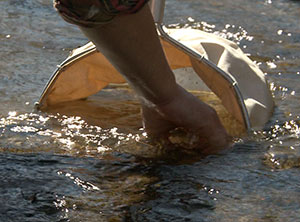Explore and Restore Maryland Streams
Main_Content
(1) Biological Assessment of Stream Health
Looking at biological indicators of stream quality is different for freshwater and saltwater habitats.
For freshwater streams– macroinvertebrates as indicators

Benthic Index of Biotic Integrity: Conducting a biological assessment of a stream involves capturing and identifying macroinvertebrates (aquatic insects and their larvae, and more), which serve as indicators of the health of freshwater streams. Macroinvertebrates are part of the aquatic food web, easy to collect without expensive equipment. Data obtained by Macroinvertebrate sampling offers good insight into the longer term functioning health of a stream and can tell us if this stream needs additional data collection, such as water chemistry analysis.
Background content: Maryland Biological Stream Survey biologists have shared a classroom presentation that describes how a stream functions and provides an introduction to the taxonomy and significance of the macroinvertebrates and other animals you may find in your stream.
Recommended reference with background ecology information and field guide: Voshell,Jr., J. Reese. A Guide to Freshwater Invertebrates of North America. Mc Donald & Woodward Publishing Co. Blacksburg, VA. 2002
 Macroinvertebrate Ecology, Maryland State Envirothon – includes background information on benthic macroinvertebrates and the stream community, insect anatomy, explanation of different sampling methods.
Macroinvertebrate Ecology, Maryland State Envirothon – includes background information on benthic macroinvertebrates and the stream community, insect anatomy, explanation of different sampling methods.
- Check out the interactive photos in the Aquatic Macroinvertebrate Collection from the Carnegie Museum of Natural History. These close-up pictures allow students to get a closer look at the insects they will find and recognize the variability possible between animals.
Share your findings: Upload the stream data collected by students at Maryland Fieldscope and then find additional data to use in the classroom to compare, analyze, track trends, and more.
Investigate further: Use this  Stream Microhabitats Lesson Plan with students to identify and explore different habitats within your stream. This lesson gives students the background information necessary to make predictions and investigate which animals can be found where in a stream and why.
Stream Microhabitats Lesson Plan with students to identify and explore different habitats within your stream. This lesson gives students the background information necessary to make predictions and investigate which animals can be found where in a stream and why.
For freshwater streams – macroinvertebrates as indicators
Salamander Index of Biotic Integrity: Collecting and identifying stream salamanders following an adapted MBSS protocol allows for an alternative way to assess the health of a stream. Stream salamanders breathe entirely through their skin which makes them ideal candidates for monitoring environmental stressors in a watershed.
- Follow this
 protocol to collect stream salamanders. Use this dichotomous key to identify the species you find. Remember, there are many other species of salamanders in Maryland that may also be found close to a stream. If you believe one or several species you find are different species, use this broader dichotomous key to determine which species you may have found. Find the MBSS dichotomous key used by the professionals here.
protocol to collect stream salamanders. Use this dichotomous key to identify the species you find. Remember, there are many other species of salamanders in Maryland that may also be found close to a stream. If you believe one or several species you find are different species, use this broader dichotomous key to determine which species you may have found. Find the MBSS dichotomous key used by the professionals here.
- Use these identification sheets to aid in identifying the salamander species along with the dichotomous keys.
- Follow this
 complete lesson for a broader understanding of salamander physiology and where we expect to find these animals in Maryland.
complete lesson for a broader understanding of salamander physiology and where we expect to find these animals in Maryland.
Equipment:
- Equipment Recomme
 ndations for chemistry kits, stream sampling equipment, and other useful streamside stream side equipment. (hyperlink would not show up for this link)
ndations for chemistry kits, stream sampling equipment, and other useful streamside stream side equipment. (hyperlink would not show up for this link)
- Make your own monitoring equipment. Build underwater viewers for observing Macroinvertebrates and other stream features. Bring in math and STEM skills by building trundle wheels for measuring along the stream bank. Plan ahead by placing Hester-Dendy Samplers and leaf packs in the stream for Macroinvertebrates to colonize.
 Safety Protocols: Remember to ALWAYS follow safety protocols at your stream!
Safety Protocols: Remember to ALWAYS follow safety protocols at your stream!